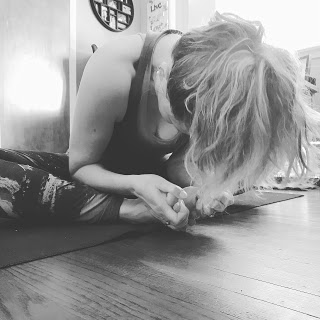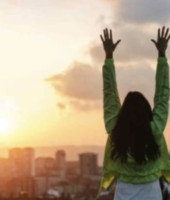Learning to Grow from the Challenge of Quarantine
I remember that our conversation touched on mundane things, like what we did all day, but then shifted to how practicing our Catholic faith had moved to an online environment, which we both felt grateful to have, while still recognizing its limitations.
I can’t speak for my mom, but Holy Week and Easter are my favorite periods on the liturgical calendar. This part of my faith practice has so many rituals and practices – that I have experienced in person – all of which have been moved to a screen. I thought about writing this post after I talked to my mom on Easter Sunday. I know that was a while ago, but what is time anyway anymore? What day is it, even?

Yes, the speakers of my mobile device let me hear the Gospel. Yes, the screen showed me the priests and even Pope Francis saying Mass. Yes, I was able to pray along.
But I could not smell the incense.
Nor could I witness the glow as the single Paschal Candle enters the completely darkened church. Its flame lights candles held by members of the congregation. They then pass that light to the person next to them and so on, the light is passed throughout, slowly illuminating the church on Holy Saturday during the vigil.
I could not feel the vibrations of the huge pipe organ or sing with my choir in sounds soft, low and mournful on Good Friday or loud and joyful with a glorious Hallelujah Chorus on Easter morning.
It was not the same. I will truthfully admit it was hard for me to connect to the Mass in the same way. I missed the physical sensations of being in the church. The feedback.
I remember my mom remarking similarly. She noted that it must be tough for the priests – even though they are in the space, performing these rituals – for all intents and purposes, to speak to empty pews. I imagine as she did, that this might leave the priests feeling a sense of achy, painful loss.
Comedian Jerry Seinfeld says he doesn’t share stand-up material on his social networks – he refuses to do this because he gets no feedback on how each joke lands. Yoga teachers I’ve spoken to have some familiarity with this aspect of teaching yoga online. They’ve lost the way to get feedback in what is a very “feedback reliant” form of movement/exercise/practice. We miss the one on one. We miss “reading the room” so we can amp things up or slow them down based on the yogis in the room. Forget hands-on assists. They went away long before the studios shut down, but they too are a method of feedback removed from the online environment.
If we dwell on this, we feel achy, we feel pain, we feel loss.
But maybe, just maybe, this is the best time to be a priest and the best time to be a yogi. I can’t speak for the priests, because I’m not one, but I will speak as a yogi because I am. Yoga teaches us to recognize the difference between pain and suffering and how to move away from it having gained something useful.
I would never choose this isolation/quarantine time for anyone – yet I am seeking ways to grow from it. The challenge of teaching online may actually have made my practice more meaningful, deeper somehow. My home practice is definitely at a new level. I even warm up before teaching, regardless of whether I’ve practiced that day or not. I’ve found myself relying on pranayama and meditation more than ever these days and I’m learning new things every day about yoga.
Thanks to free offerings from the Yoga Alliance, (and some of my extra time freed up by no longer commuting ANYWHERE) I attended a four-part workshop series with Jafar Alexander E-RTY500 to enhance some of my understanding about the Yoga Sutras. In one part of the workshop, Alexander offered this way to explain the difference between pain (fleeting) and suffering (lingering).
Let’s say your dog is crying to be let out in the middle of the night. You wake, stumble in the dark to get to the door and in the process, stub your toe on the coffee table. Ouch! There’s the pain. You let the dog out and rub your toe, annoyed. The pain subsides and you let the dog back in and go back to sleep. The pain has a beginning a middle and an end.
Let’s say the next morning, you’re groggy from the interrupted sleep and so you begin to add suffering to the stubbed toe pain. Why did the dog have to wake me? Who put that coffee table there? Why did we have to get a dog in the first place? Ouch! There’s the suffering. You are adding to the pain by creating a story around it.
Pain is a thing that happens to all of us, every day it seems to happen sometimes. Yet, suffering is a story that we wrap around that event of pain and carry with us. Suffering is the act of taking our pain and perpetuating it – the suffering then weighs us down and it keeps us from seeing the next amazing thing in front of us.
If we can agree that getting up in the middle of the night to let the dog out and stubbing your toe in the process is painful – that is one thing. Is it possible to take a lesson from that painful moment and move forward to avoid future pain? Maybe remembering that the table is there or putting a nightlight somewhere so you can see what blocks your path better.
If we can agree that this quarantine time is painful – that is helpful information. Missing the in-person elements of practice and events and family gatherings is painful. How can we use that pain to help us see the next amazing thing? How can that pain can teach us a lesson?
I don’t claim to have the answer, but what I do know is we grow when we view pain as an opportunity to learn ways in which we can lessen any future pain. I acknowledge that I’m speaking from a place of privilege because I CAN stay home safely and still work and teach. This acknowledgment gave me a new found respect for what my home environment has become – a safe space, my home yoga studio.
Rather than focusing on what I’ve lost, the smell of incense, the visceral sound of Handel’s Hallelujah Chorus ringing out from a pipe organ, the ability to use hands-on adjustments to guide a student more deeply into a pose… I’m focusing on what I’ve gained.







